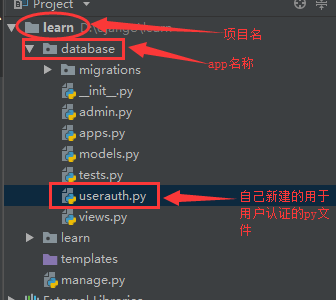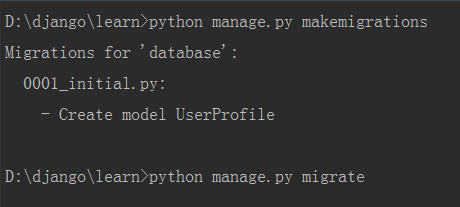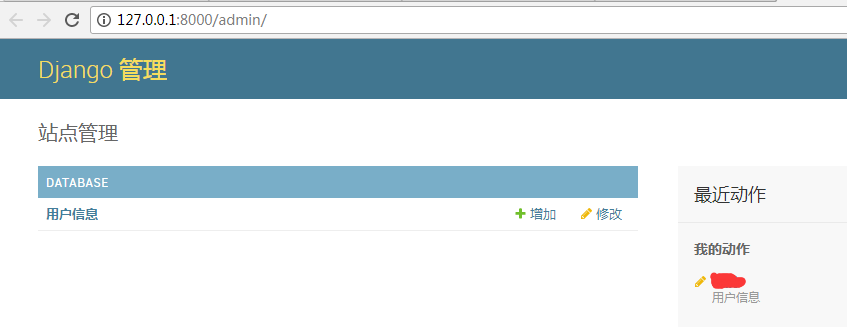自定义用户认证(继承django的)
1、在app下创建一个自己用户认证文件,文件名随意,记得为.py文件

2、编辑该userauth.py文件
#!/usr/bin/env python
#coding:utf-8
from django.db import models
from django.contrib.auth.models import (
BaseUserManager, AbstractBaseUser
)
import django class UserManager(BaseUserManager):
def create_user(self, email, name, password=None):
"""
Creates and saves a User with the given email, date of
birth and password.
"""
if not email:
raise ValueError('Users must have an email address') user = self.model(
email=self.normalize_email(email),
name=name,
#token=token,
#department=department,
#tel=tel,
#memo=memo, ) user.set_password(password)
user.save(using=self._db)
return user def create_superuser(self, email, name ,password):
"""
Creates and saves a superuser with the given email, date of
birth and password.
"""
user = self.create_user(email,
password=password,
name=name,
#token=token,
#department=department,
#tel=tel,
#memo=memo,
)
user.is_admin = True
user.save(using=self._db)
return user class UserProfile(AbstractBaseUser):
email = models.EmailField(
verbose_name='email address',
max_length=255,
unique=True,
) is_active = models.BooleanField(default=True)
is_admin = models.BooleanField(default=False) name = models.CharField(u'名字', max_length=32)
token = models.CharField(u'token', max_length=128,default=None,blank=True,null=True)
department = models.CharField(u'部门', max_length=32,default=None,blank=True,null=True) mobile = models.CharField(u'手机', max_length=32,default=None,blank=True,null=True) memo = models.TextField(u'备注', blank=True,null=True,default=None)
date_joined = models.DateTimeField(blank=True, auto_now_add=True)
valid_begin_time = models.DateTimeField(default=django.utils.timezone.now)
valid_end_time = models.DateTimeField(blank=True,null=True) USERNAME_FIELD = 'email' #定义email为用户名
#REQUIRED_FIELDS = ['name','token','department','tel','mobile','memo']
REQUIRED_FIELDS = ['name'] def get_full_name(self):
# The user is identified by their email address
return self.email def get_short_name(self):
# The user is identified by their email address
return self.email def __str__(self): # __unicode__ on Python 2
return self.email def has_perm(self, perm, obj=None):
"Does the user have a specific permission?"
# Simplest possible answer: Yes, always
return True
def has_perms(self, perm, obj=None):
"Does the user have a specific permission?"
# Simplest possible answer: Yes, always
return True
def has_module_perms(self, app_label):
"Does the user have permissions to view the app `app_label`?"
# Simplest possible answer: Yes, always
return True @property
def is_staff(self):
"Is the user a member of staff?"
# Simplest possible answer: All admins are staff
return self.is_admin class Meta:
verbose_name = u'用户信息'
verbose_name_plural = u"用户信息"
def __unicode__(self):
return self.name objects = UserManager()
3、在models中导入该文件中的UserProfile类

4、admin中注册
编辑admin.py文件
#_*_coding:utf8_*_
from django.contrib import admin # Register your models here. from django import forms
from django.contrib import admin
from django.contrib.auth.models import Group
from django.contrib.auth.admin import UserAdmin
from django.contrib.auth.forms import ReadOnlyPasswordHashField
import models from userauth import UserProfile
from django.contrib.auth import forms as auth_form class UserCreationForm(forms.ModelForm):
"""A form for creating new users. Includes all the required
fields, plus a repeated password."""
password1 = forms.CharField(label='Password', widget=forms.PasswordInput)
password2 = forms.CharField(label='Password confirmation', widget=forms.PasswordInput) class Meta:
model = UserProfile
fields = ('email','token') def clean_password2(self):
# Check that the two password entries match
password1 = self.cleaned_data.get("password1")
password2 = self.cleaned_data.get("password2")
if password1 and password2 and password1 != password2:
raise forms.ValidationError("Passwords don't match")
return password2 def save(self, commit=True):
# Save the provided password in hashed format
user = super(UserCreationForm, self).save(commit=False)
user.set_password(self.cleaned_data["password1"])
if commit:
user.save()
return user class UserChangeForm(forms.ModelForm):
"""A form for updating users. Includes all the fields on
the user, but replaces the password field with admin's
password hash display field.
"""
password = ReadOnlyPasswordHashField(label="Password",
help_text=("Raw passwords are not stored, so there is no way to see "
"this user's password, but you can change the password "
"using <a href=\"password/\">this form</a>.")) class Meta:
model = UserProfile
fields = ('email', 'password','is_active', 'is_admin') def clean_password(self):
# Regardless of what the user provides, return the initial value.
# This is done here, rather than on the field, because the
# field does not have access to the initial value
return self.initial["password"]
class UserProfileAdmin(UserAdmin):
# The forms to add and change user instances
form = UserChangeForm
add_form = UserCreationForm # The fields to be used in displaying the User model.
# These override the definitions on the base UserAdmin
# that reference specific fields on auth.User.
list_display = ('id','email','is_admin','is_active')
list_filter = ('is_admin',)
fieldsets = (
(None, {'fields': ('email', 'password')}),
('Personal info', {'fields': ('department','name','mobile','memo')}),
('API TOKEN info', {'fields': ('token',)}),
('Permissions', {'fields': ('is_active','is_admin')}),
('账户有效期', {'fields': ('valid_begin_time','valid_end_time')}),
)
# add_fieldsets is not a standard ModelAdmin attribute. UserAdmin
# overrides get_fieldsets to use this attribute when creating a user.
add_fieldsets = (
(None, {
'classes': ('wide',),
'fields': ('email', 'password1', 'password2','is_active','is_admin')}
),
)
search_fields = ('email',)
ordering = ('email',)
filter_horizontal = () # Now register the new UserAdmin...
admin.site.register(models.UserProfile,UserProfileAdmin)
admin.site.unregister(Group)
#这里需注意,第51行
"using <a href=\"password/\">this form</a>.")) #这是django1.8的写法,如果>1.8的话需要修改成
"using <a href=\"../password/\">this form</a>."))
否则在admin后台点击修改密码的话会提示404找不到页面
5、在settings告诉django使用我们自己定义的用户认证系统
修改settings,结尾添加
AUTH_USER_MODEL = 'database.UserProfile'
#database为app名称
#UserProfile为我们刚才在userauth.py中创建的类名称
6、同步数据库

可以看到创建了UserProfile表,这样就可以直接使用django的用户认证功能
7、创建超级用户

可以看到提示已经跟django默认的不一样了,以email地址作为用户名
8、此时访问django admin

自定义用户认证(继承django的)的更多相关文章
- 使用django实现自定义用户认证
参考资料:https://docs.djangoproject.com/en/1.10/topics/auth/customizing/ 直接拉到最后看栗子啦 django自定义用户认证(使用自 ...
- Django自定义用户认证
自定义一个用户认证 详细参考官方文档: https://docs.djangoproject.com/en/1.9/topics/auth/customizing/#django.contrib.au ...
- Django自定义用户认证系统之自定义用户模型
参考文档:http://python.usyiyi.cn/django/topics/auth/customizing.html Django 自带的认证系统足够应付大多数情况,但你或许不打算使用现成 ...
- CMDB资产管理系统开发【day25】:Django 自定义用户认证
官方文档:https://docs.djangoproject.com/en/1.10/topics/auth/customizing/#substituting-a-custom-user-mode ...
- Django--分页器(paginator)、Django的用户认证、Django的FORM表单
分页器(paginator) >>> from django.core.paginator import Paginator >>> objects = ['joh ...
- 43)django-用户认证,授权,自定义用户认证
##用户认证 django自带用户认证系统,包括认证和授权.用户认证系统由用户,权限,用户组,密码,cookie和session给组成. ###用户认证系统设置 #settings.py INSTAL ...
- YII2中自定义用户认证模型,完成登陆和注册
有些时候我们需要自已定义用户类,操作自已建的用户表,来完成登陆和注册功能. 用户表结构如下,当然可以根据自已的需要添加或删除: CREATE TABLE `tb_user` ( `id` int(11 ...
- spring Security的自定义用户认证
首先我需要在xml文件中声明.我要进行自定义用户的认证类,也就是我要自己从数据库中进行查询 <http pattern="/*.html" security="no ...
- Django自定义用户认证系统Customizing authentication
扩展已有的用户模型Extending the existing User model 有两种方法来扩展默认的User Model而不用重写自己的模型.如果你不需要改变存储在数据库中的字段,而只是需要改 ...
随机推荐
- Chapter 2 User Authentication, Authorization, and Security(3):保护服务器避免暴力攻击
原文出处:http://blog.csdn.net/dba_huangzj/article/details/38756693,专题目录:http://blog.csdn.net/dba_huangzj ...
- ios swift模仿qq登陆界面,xml布局
给大家推荐两个学习的地址: 极客学院的视频:http://www.jikexueyuan.com/path/ios/ 一个博客:http://blog.csdn.net/lizhongfu2013/a ...
- 【一天一道LeetCode】#58. Length of Last Word
一天一道LeetCode系列 (一)题目 Given a string s consists of upper/lower-case alphabets and empty space charact ...
- 015-OC基础语法-OC笔记
学习目标 1.[了解]Objective-C语言简介 2.[掌握]第一个OC程序 3.[掌握]OC中的字符串 4.[熟悉]OC中的一些玩意 5.[了解]面向过程与面向对象 6.[掌握]类的声明和实现 ...
- mysql进阶(二十一)删除表数据
MySQL删除表数据 在MySQL中有两种方法可以删除数据,一种是DELETE语句,另一种是TRUNCATE TABLE语句.DELETE语句可以通过WHERE对要删除的记录进行选择.而使用TRUNC ...
- J2EE进阶(一)随堂笔记
进公司搞研发,基本上用的都是J2EE框架.若想在公司混个不错的地位,首先技术上必须过关.由于需求所致,自己学习了J2EE一段时间,主要是Struts2,MyBatis(Hibernate的前身),远远 ...
- SpriteBuilder中的CCSprite9Slice是个什么鬼?
CCSprite大家都知道,但是加上后面那一串又变成了神马呢? 我们可以首先到官方的API文档网站查一下,如下: http://www.cocos2d-swift.org/docs/api/Class ...
- iOS监听模式系列之iOS开发证书、秘钥
补充--iOS开发证书.秘钥 iOS开发过程中如果需要进行真机调试.发布需要注册申请很多证书,对于初学者往往迷惑不解,再加上今天的文章中会牵扯到一些特殊配置,这里就简单的对iOS开发的常用证书和秘钥等 ...
- Android 高逼格纯代码实现类似微信钱包带分割线的GridView
前言 原文地址:http://blog.csdn.net/sk719887916/article/details/40348837: Tamic 通过上两篇关于自定view的文章,在自定义vie ...
- 介绍一种很棒的wince 如何替换系统声音的方法
Topic:介绍一种很棒的wince 如何替换系统声音的方法(作者:Baiduluckyboy) //------------------------------------------------- ...
